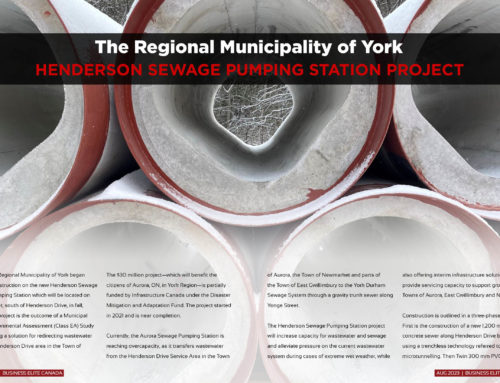New Wastewater Treatment Facility Opens Town To Growth
By Tina Costanza
The Town of Lumsden, Saskatchewan, will no longer be forced to restrict its population growth, now that a new wastewater treatment facility is replacing an aging sewage lagoon system that’s unable to expand.
The new facility, which could meet the needs of up to double the town’s current population of about 2,000 people, will also do a better job of protecting the environment.
Town Councillor Rhonda Phillips, who is also the chair of the Wastewater Treatment Committee, describes Lumsden as “a really vibrant community” in “a spectacularly beautiful setting.” Lumsden is nestled in the Qu’Appelle Valley, along a river that flows into a series of prairie lakes. Even though it’s only 20 to 30 kilometres away from the provincial capital, Regina, it contains all the services anybody would want, from restaurants to grocery stores, to boutiques and coffee shops.
To open the town to growth, the new $20.3-million wastewater treatment facility will include a new lift station and force main extension, screening, odour control, sequencing batch bioreactors, tertiary filtration, alum precipitation, UV disinfection, and an outfall structure which would discharge treated effluent into the Qu’Appelle River or direct treated effluent for reuse, the Town of Lumsden says. The solid stream treatment includes anoxic aerobic digestors and dewater presses to produce a sludge of a quality that can be reused.
The discharged effluent will meet strict guidelines, as set out by the Water Security Agency (WSA).
“The old lagoon system is about 50 years old and it’s under sized for the size of the community right now,” says Phillips. “We were in real flood conditions here, specifically in 2011, but from 2010 to 2014. We were required to do an emergency discharge into an adjacent wetland pretty much every year during those wet years, which obviously from an environmental perspective isn’t acceptable.”
On those occasions, special permits have been required from the WSA for an emergency discharge. With the new facility, wastewater will be collected in a lift station and pumped to the new site, where it will be filtered and cleaned. Then it will be disinfected and released into the river. Water will be removed from the solids before they’re sent to a landfill.
This process not only reduces the plant’s environmental impact, it gives the town more control over the treatment process.
The project will be developed in two stages, the town says. Stage 1 will serve the community until about 2030. When the population and maximum monthly flow reach a limit, the stage 2 upgrade will be conducted and should suffice until about 2046, depending on the rate of population growth.
Between the Town of Lumsden, suppliers, regulators, engineers, construction workers, subcontractors, and utility companies, more than 1,000 people are working on the project.
Funding partners
Funding for the project is coming from the federal, provincial and municipal governments. Under the New Building Canada Fund’s Provincial Territorial Infrastructure Component, National and Regional Projects program, the Government of Canada and the Government of Saskatchewan are each contributing more than $6.7 million toward the project. The Town of Lumsden is responsible for the remaining costs.
“We are very grateful to Canada and Saskatchewan for their funding assistance,” says Phillips.
In anticipation of the project, the town began adding a $40 surcharge to residents’ bills four or five years ago. That charge will stay in place as the town works to cover the remaining costs.
Stantec Consulting Ltd. completed the design for the new facility in 2018. The preparation of the site began that fall, and Graham Construction broke ground on the project in the spring of 2019. The goal is for the entire project to be finished and operational by late 2020.
“It’s more or less on time,” says Phillips. “Anything that has slowed us down has been around the time it took for the detailed design. It’s a complicated process for a very small plant. The engineers were challenged with trying to scale down what would normally be a process in a really large plant to a plant for the size of our community. It’s getting done and it’s getting done well.”
“Once construction started it’s been going pretty steady, and if anything’s not, they’ve had the flexibility to switch over to working on something different,” Phillips adds. “We’re not done yet, but the idea would be for this project to be completed by early 2021 and the engineers are telling us they’re feeling very confident that they’re going to be able to meet that date.”
The lift portion is expected to be commissioned in August and will be turned over to the town by September.
“There’s a few problems with COVID-19 but they haven’t really developed all the way,” Phillips says.
Input from the community
A lot of community consultation has helped shape the project.
“I was elected to council in 2009. Before that, there had been work done on the project, but it wasn’t really getting anywhere,” Phillips explains. “Not any fault of the people who were working on the project, you just kind of have to be very persistent to keep something like this moving ahead.”
In 2009, Phillips and a couple of other new councillors decided to take on the project and developed what they called Sewage 101. The first year consisted of research and speaking to experts, and then working with a company for a preliminary design.
“We looked at all of our different options and decided that a tertiary treatment plant in the valley bottom was the best option,” Phillips says. “There was no room to expand the lagoon, and that wasn’t something we were interested in doing, anyway.”
The town has been keeping residents appraised of the work on the project through public information meetings, its website and social media channels.
Protecting the environment
The Wastewater Treatment Committee has taken a close look at how to reduce the environmental impact of the new plant.
“The wastewater treatment plant uses a huge amount of electricity because it has blowers and bubblers and pumps,” Phillips explains. “Once we realized that in the preliminary design phase, we were really quite concerned, because we’re sort of trading one environmental problem — the contamination of the Qu’Appelle River — for another, the production of greenhouse gases through using electricity. In Saskatchewan, a big portion of our electricity comes from non-renewable resources. So we wanted to investigate using renewable energy to run this plant. And so we’re just in the final stages of a contract for building a huge solar array and battery storage system that will provide renewable energy — solar energy — for 66 per cent of the plant operations. And then with the lift station, that grid tied solar will go in next week (at time of writing). It will completely offset the electrical consumption for the main lift station so that It should be net zero.”
Other buildings in town, such as the recycling centre, will also be outfitted with a solar array.
“It will be net zero by the end of June. And there’s going to be a future lift station in a newer development, and it will be run by solar, as well.”
https://lumsden.ca/app/uploads/2018/11/Lumsden-WWTP-Background-September-2017.pdf






